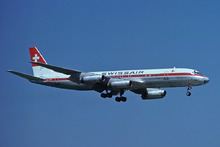Crew 12 Survivors 140 Survivor 140 | Passengers 142 Injuries (non-fatal) 10 Date 7 October 1979 Fatalities 14 Passenger count 142 | |
 | ||
Summary Runway overrun caused by pilot error Similar Dan‑Air Flight 0034, Quebecair Flight 255, Air New England Flight 248, Alia Royal Jordanian Flight 600, Downeast Flight 46 | ||
On 7 October 1979, a Swissair DC-8 crashed while attempting to land at Athens-Ellinikon International Airport. Of the 154 passengers and crew on board, 14 perished in the accident.
Contents
The crash
Swissair Flight 316 was an international scheduled passenger service from Geneva, Switzerland to Athens, Greece. The aircraft, named Uri, was piloted by Fritz Schmutz with co-pilot Martin Deuringer.
Flight 316 touched down on runway 15L at a speed of 146 knots (270 km/h; 168 mph). The aircraft decelerated but overran the runway and came to rest on a public road. The left wing and tail separated and fire broke out. 14 of the 142 passengers on board perished. Among the dead were British, German, and French citizens. Of the passengers on board, 100 were doctors on their way to a medical convention in China.
Survivors of Flight 316's included Hans Morgenthau, a professor emeritus from the University of Chicago and expert in International Relations and Lakshman Kadirgamar later Minister of Foreign Affairs of Sri Lanka.
Aftermath
After the crash it was learned that the aircraft was transporting over 1,000 pounds (450 kg) of radioactive isotopes and a small amount of plutonium. The plutonium was in the luggage of one of the doctors on board, and was briefly missing in the aftermath of the crash, although it was quickly found. Authorities had firemen and other rescue workers checked for radiation exposure.
The crash destroyed over $2 million worth of industrial diamonds bound for Bombay. Most of the uncut diamonds were found by police, but they were destroyed by the crash's intense heat.
Two days after the crash of Flight 316, Greek authorities charged pilot Fritz Schmutz with manslaughter plus other charges. At a trial in 1983, Schmutz, along with co-pilot Deuringer, were found guilty of multiple charges including manslaughter with negligence, causing multiple bodily injury, and obstructing air traffic, and were sentenced to five and two and a half years in prison respectively. Schmutz and Deuringer were set free on bail while they appealed their sentences. A year after their sentencing, the court ruled Schmutz and Deuringer could substitute fines in place of jail time. Neither pilot had flown since the accident, but they were employed by Swissair.
Cause
The accident investigation determined the causes of the accident were that the crew touched down too far down the runway, at too high a speed, following a non-stabilised approach, and that they failed to properly utilise the aircraft's brake and reverse thrust systems, which resulted in their being unable to stop the aircraft within the available runway and overrun distance.
One member of the Operations team of the Accident Investigation Committee had a different opinion from the rest of the Committee regarding the cause of the accident, stating that he believed the crew failed to realise the touchdown speed and distance, failed to follow the company's poor-braking-action landing technique, and failed to properly utilise the aircraft's brake and reverse thrust systems.
